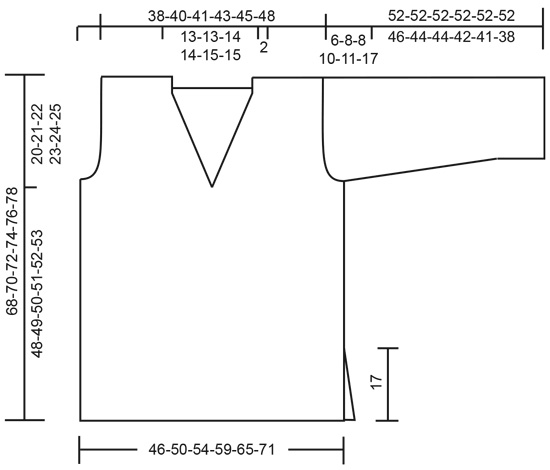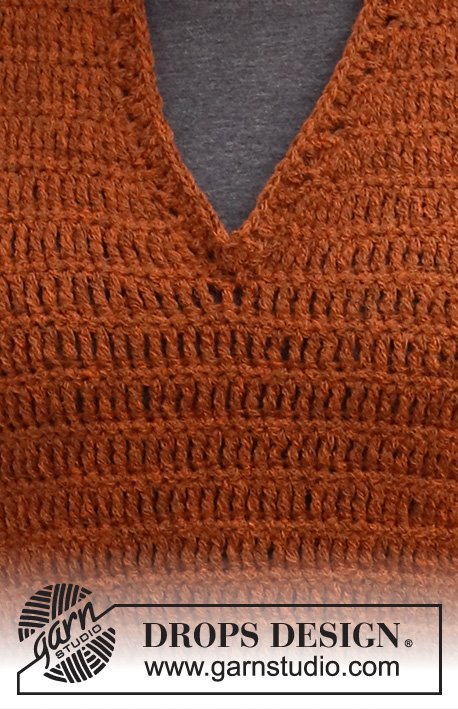Rustic Roots |
|
 |
 |
Crocheted sweater in DROPS Sky. Piece is crocheted top down with V-neck and vents in the sides. Size: S - XXXL
DROPS 217-27 |
|
|
------------------------------------------------------- EXPLANATION FOR THE PATTERN: ------------------------------------------------------- CROCHET TIP FOR CHAIN STITCH: If you work at the end of crochet hook the chain stitch will often be too tight. 1 chain stitch should be just as long as 1 single crochet/treble crochet is wide. CROCHET INFORMATION: On every row with single crochets, work 1 chain stitch at beginning of row. This chain does not replace first stitch. On every row with treble crochets, work 4 chain stitches at beginning of row. These 4 chain stitches does not replace first treble crochet but are worked in addition. INCREASE TIP: Increase 1 stitch by working 2 stitches in a stitch. DECREASE TIP (applies to sleeves): Work 2 single crochets together into 1 single crochet: Insert hook in next stitch, get yarn *, work from *-* 2 times in total, make 1 yarn over and pull yarn through all 3 loops on hook (= 1 stitch decreased). Work 2 treble crochets together into 1 treble crochet: Work 1 treble crochet but wait with last yarn over and pull through, work 1 treble crochet more the same way. Make 1 yarn over on hook and pull through all 3 loops on hook (= 1 treble crochet decreased). ------------------------------------------------------- START THE PIECE HERE: ------------------------------------------------------- SWEATER - SHORT OVERVIEW OF THE PIECE: Back piece and front piece is work back and forth in parts, top down. Work sleeves back and forth, top down. Finally sew parts together and crochet an edge around the neck. BACK PIECE: Right shoulder: Work 21-23-23-24-25-27 chain stitches - read CROCHET TIP FOR CHAIN STITCH, on hook size 4.5 mm = US 7 with Sky. Turn and work pattern as follows: ROW 1 (right side): Work 4 chain stitches - read CROCHET INFO, work 1 treble crochet in every chain stitch = 21-23-23-24-25-27 treble crochets. ROW 2 (wrong side): Work 1 single crochet in every stitch. Cut the yarn and work left shoulder. REMEMBER THE CROCHET GAUGE! Left shoulder: Work 21-23-23-24-25-27 chain stitches - remember CROCHET TIP FOR CHAIN STITCH, on hook size 4.5 mm = US 7 with Sky. Turn and work pattern as follows: ROW 1 (right side): Work 4 chain stitches - remember CROCHET INFO, work 1 treble crochet in every chain stitch = 21-23-23-24-25-27 treble crochets. ROW 2 (wrong side): Work 1 single crochet in every stitch. Now work the 2 parts together as follows: ROW 3: Work 1 treble crochet in every stitch until 1 stitch remains on left shoulder, work 2 treble crochets in next stitch, work 18-18-20-20-22-22 loose chain stitches (= neck), then continue over stitches from right shoulder as follows: Work 2 treble crochets in first stitch, work 1 treble crochet in each of the remaining 20-22-22-23-24-26 stitches = 62-66-68-70-74-78 stitches. Work back and forth with treble crochet from right side and single crochets from wrong side. When piece measures 17-17-17-15-14-12 cm = 6¾"-6¾"-6¾"-6"-5½"-4¾" from shoulder, begin increase for armhole. Increase 1 stitch by working 2 stitches in edge stitch in each side of piece on every row 2-3-4-6-8-10 times in total in each side = 66-72-76-82-90-98 stitches. At the end of the next 2 rows work 5-5-6-7-8-9 loose chain stitches for armholes = 76-82-88-96-106-116 stitches. Work the new stitches in pattern, i.e. every other row with single crochets and treble crochets. When piece measures 68-70-72-74-76-78 cm = 26¾"-27½"-28⅜"-29⅛"-29½"-30¾" from shoulder, adjust to finish after a row with single crochets. The back piece is finished. Cut and fasten the yarn. FRONT PIECE: Right shoulder: Work 21-23-23-24-25-27 chain stitches - remember CROCHET TIP FOR CHAIN STITCH, on hook size 4.5 mm = US 7 with Sky. Turn and work pattern as follows: ROW 1 (right side): Work 4 chain stitches - remember CROCHET INFO, work 1 treble crochet in every chain stitch = 21-23-23-24-25-27 treble crochets. ROW 2 (wrong side): Work 1 single crochet in every stitch. Continue back and forth with treble crochets from right side and single crochets from wrong side, AT THE SAME TIME on next row begin increase for V-neck. Increase 1 stitch by working 2 stitches in the second stitch towards neck on every other row (= every row with treble crochets) 2-2-3-3-4-4 times, then increase 1 stitch the same way on every row (i.e. at the end of every row with treble crochets and beginning of every row with single crochets) 8-8-8-8-8-8 times (= 10-10-11-11-12-12 stitches increased in total for V-neck). AT THE SAME TIME when piece measures 17-17-17-15-14-12 cm = 6¾"-6¾"-6¾"-6"-5½"-4¾" from shoulder, begin increase for armholes. Increase 1 stitch by working 2 stitches in the edge stitch towards the side on every row 2-3-4-6-8-10 times in total, and at the end of next row from wrong side work 5-5-6-7-8-9 loose chain stitches for armhole. When all increases for V-neck and armholes are done, there are 38-41-44-48-53-58 stitches on right shoulder – adjust to finish after a row from right side. Cut the yarn and put piece aside. Left shoulder: Work 21-23-23-24-25-27 chain stitches - remember CROCHET TIP FOR CHAIN STITCH, on hook size 4.5 mm = US 7 with Sky. Turn and work pattern as follows: ROW 1 (right side): Work 4 chain stitches- remember CROCHET INFO, work 1 treble crochet in every chain stitch = 21-23-23-24-25-27 treble crochets. ROW 2 (wrong side): Work 1 single crochet in every stitch. Continue back and forth with treble crochets from right side and single crochets from wrong side, AT THE SAME TIME on next row begin increase for V-neck. Increase 1 stitch by working 2 stitch in the second stitch from the neck on every other row (= every row with treble crochets) 2-2-3-3-4-4 times, then increase 1 stitch on every row (i.e. at the beginning of every row with treble crochets and at the end of every row with single crochets) 8-8-8-8-8-8 times (= 10-10-11-11-12-12 stitches increased in total for V-neck). AT THE SAME TIME when piece measures 17-17-17-15-14-12 cm = 6¾"-6¾"-6¾"-6"-5½"-4¾" from shoulder, begin increase for armholes. Increase 1 stitch by working 2 stitches in edge stitch towards the side on every row 2-3-4-6-8-10 times. At the end of next row from right work 5-5-6-7-8-9 loose chain stitches for armhole. When all increases for V-neck and armholes are done, there are 38-41-44-48-53-58 stitches on left shoulder – adjust to finish after a row from right side. Now work the 2 parts together from wrong side follows: Turn and work as before over stitches on left shoulder, then work over stitches from right shoulder = 76-82-88-96-106-116 stitches. Continue back and forth with every other row with treble crochets and single crochets. When piece measures 68-70-72-74-76-78 cm = 26¾"-27½"-28⅜"-29⅛"-29½"-30¾" from shoulder, adjust to finish after a row with single crochets. The back piece is finished. Cut and fasten the yarn. SLEEVES: Work 40-41-42-42-42-40 chain stitches - remember CROCHET TIP FOR CHAIN STITCH, on hook size 4.5 mm = US 7 with Sky. Work 1 single crochet in every stitch from right side and work 1 single crochet in every stitch from wrong side - remember CROCHET INFO, AT THE SAME TIME increase 1 stitch in each side by working 2 stitches in the edge stitch in each side of sleeve. Continue back and forth like this until 5-6-6-8-9-11 stitches have been increased in total in each side = 50-53-54-58-60-62 stitches. At the end of the next 2 rows work 5-5-6-7-8-9 loose chain stitches(= armholes) = 60-63-66-72-76-80 stitches. Work the new stitches in pattern, i.e. every other row with single crochets and treble crochets. When piece measures approx. 3 cm = 1⅛" from where 5-5-6-7-8-9 loose chain stitches were worked for armhole in each side, begin decrease in each side of sleeve - read DECREASE TIP. Decrease 1 stitch in each side on every row 2-3-4-8-8-10 times and on every 4th row 6-6-6-4-4-4 times = 44-45-46-48-52-52 stitches. Continue until sleeve measures 52-52-52-52-52-52 cm = 20½"-20½"-20½"-20½"-20½"-20½" in total - adjust to finish after a row with single crochets. Fasten off. Work the other sleeve the same way. ASSEMBLY: Sew shoulder seams in one and one stitch to avoid a chunky seam. Sew sleeves in body. Sew seam under sleeves and down along body until approx. 17 cm = 6¾" remain (= vent). NECK EDGE: Begin tip in V-neck at the front and work from wrong side as follows: Fasten yarn with 1 single crochet in the tip, * work 2 chain stitches, skip 1 cm = ⅜", work 1 single crochet *, work from *-* around the entire neck and adjust to finish with 1 single crochet beside the first single crochet worked in tip on V-neck. Turn and work as follows from right side: Work 3 chain stitches, then work 2 double crochet around every chain space around the neck. Cut the yarn. Place one row with double crochets over the other row with double crochets in the tip on V-neck and sew a couple of invisible stitches to fasten rows together. Fasten off. |
|

|
|
|
Have you made this or any other of our designs? Tag your pictures in social media with #dropsdesign so we can see them! Do you need help with this pattern?You'll find tutorial videos, a Comments/Questions area and more by visiting the pattern on garnstudio.com. © 1982-2024 DROPS Design A/S. We reserve all rights. This document, including all its sub-sections, has copyrights. Read more about what you can do with our patterns at the bottom of each pattern on our site. |
|










































Comments / Questions (9)
Bonjour, C'est mon premier "vrai" ouvrage réalisé. Les explications sont claires, même pour une super débutante. Je pense que je le réaliserai à nouveau, mais légèrement cintré à la taille. Merci pour vos modèles et aides à la réalisation.
12.12.2023 - 15:40Hej. Kan i oplyse mål på de forskellige størrelser? Pft og mvh Christina
27.02.2023 - 15:21DROPS Design answered:
Hej Christina, du finder blusens mål i måleskitsen nederst i opskriften :)
28.02.2023 - 14:43Buongiorno, ho 1 domanda: quando il pattern dice: Aumentare 1 maglia lavorando 2 maglie nella maglia di vivagno verso il lato su ogni riga 2-3-4-6-8-10 volte in totale, il 'verso il lato' si riferisce al lato vivagno o all'interno del maglione Grazie
05.02.2022 - 09:35DROPS Design answered:
Buonasera Annabella, si fa riferimento proprio all'esterno del lavoro. Buon lavoro!
05.02.2022 - 21:02Wat word er bedoeld met: hier worden aanvullend dubbele stokjes op gehaakt?
18.03.2021 - 17:32DROPS Design answered:
Dag Deborah,
Normaal vervangen de 4 lossen het eerste dubbele stokje op de toer, maar nu worden deze 4 lossen er extra bij gehaakt, dus niet in plaats van het eerste dubbele stokje, maar aanvullend.
21.03.2021 - 11:04Hoeveel bollen worden er gebruikt?
18.01.2021 - 14:57DROPS Design answered:
Dag Anja,
Bovenaan bij de materialenlijst staat per maat aangegeven hoeveel gram je nodig hebt. (Het eerste getal is voor maat S, het tweede getal voor maat M, enzovoort). 1 bol weegt 50 gram, dus als er bijvoorbeeld 400 gram staat heb je 8 bollen nodig.
22.01.2021 - 16:07Bonjour, il n'ya pas une erreur pour les augmentations de la manche ? Si on les fait sur 11 rang, ça fait une manche courte !
30.11.2020 - 13:16DROPS Design answered:
Bonjour Sophie, quand les augmentations sont faites 11 fois de chaque côté (XXXL), vous avez crocheté 22 rangs au total et vous montez encore 9 mailles en l'air à la fin des 2 rangs suivants pour les emmanchures. Vous continuez ensuite la partie "longue" de la manche en diminuant de chaque côté. J'espère avoir pu vous débloquer. Bon crochet!
30.11.2020 - 16:09Jeg stusser på størrelsen på heklenålen ift bytte til tynnere eller tykkere nål. Er det ikke motsatt?
20.10.2020 - 16:37ESTA PRENDA ES LINDA PARA JOVENES , SUELTA INFORMAL, LINDA
05.08.2020 - 18:36I NEED to make this one!! ❤️Love❤️
04.06.2020 - 20:48